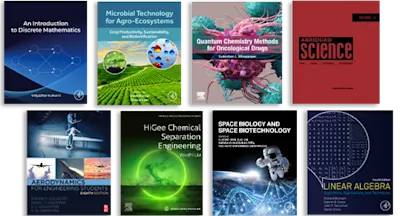
Nano-enabled Sustainable and Precision Agriculture
- 1st Edition - August 3, 2023
- Latest edition
- Editors: Peng Zhang, Iseult Lynch, J.C. White, Richard D. Handy
- Language: English
Nano-enabled Sustainable and Precision Agriculture is the first single-volume resource to cover this important field using a whole systems approach that considers both opport… Read more

Nano-enabled Sustainable and Precision Agriculture is the first single-volume resource to cover this important field using a whole systems approach that considers both opportunities and challenges. The book provides a comprehensive understanding of the role of nanotechnology in agriculture from broad aspects, but also includes a comprehensive view of the interaction of nanomaterials with soil-plant systems. It highlights aspects not described in previous books, including the application of nanoinformatics and artificial intelligence in nano-enabled sustainable agriculture, the application of nanotechnology in alternative forms of agriculture such as hydroponics, and regulatory frameworks for this research field.
The book addresses all these aspects by including sections on enhanced sustainability, reduced pollution and enhanced ecosystems' health, and the role of nanoinformatics and machine learning.
The book addresses all these aspects by including sections on enhanced sustainability, reduced pollution and enhanced ecosystems' health, and the role of nanoinformatics and machine learning.
- Provides foundational insights and resources for each area, including soil science, water chemistry, nanoscience, plant science, microbiology and nanoinformatics
- Focuses on mechanisms of action, transformations and the underpinning chemistry and biochemistry
- Includes linkages and cross-referencing between chapters to ensure a cohesive and comprehensive resource
Undergraduate, MSc. and PhD research courses such as Biotechnology, Environmental Chemistry, Agriculture / Agricultural Science, Sustainable Agriculture / Land management, Environmental Engineering etc. Scientists in the field of nanoscience, environmental science, agricultural science, soil science, aquaculture and experts in nano- and agrochemical industry and other agritech sectors
Section 1. Introduction
Section 2. Nanotechnology application in agriculture
Section 3. Interaction of nanomaterials with soil-plant system and implications for nano-enabled agriculture
Section 2. Nanotechnology application in agriculture
Section 3. Interaction of nanomaterials with soil-plant system and implications for nano-enabled agriculture
- Edition: 1
- Latest edition
- Published: August 3, 2023
- Language: English
PZ
Peng Zhang
Dr Peng Zhang obtained his Ph.D. (2013) in bioinorganic chemistry from the University of the Chinese Academy of Sciences. He was an associate professor in the Institute of High Energy Physics (CAS) from 2015 to 2018. He currently works at the School of Geography, Earth and Environmental Sciences, University of Birmingham, UK. His research interests include nano-enabled sustainable agriculture, food security, nanosafety, (eco)toxicology and environment remediation. He was awarded James J. Morgan ES&T Early Career Award 2022 for his contribution in developing innovative solutions for sustainable nanotechnology and nano-enabled agriculture. Dr Zhang is the Youth Editor for The Innovation, and on the editorial board of Reviews of Environmental Contamination and Toxicology, Frontiers in Plant Science and Frontiers in Sustainable Food Systems. He is a full member of The Society of Toxicology of USA
Affiliations and expertise
School of Geography, Earth and Environmental Sciences, University of Birmingham, UKIL
Iseult Lynch
Iseult Lynch holds a PhD in Chemistry from University College Dublin, Ireland. She is Chair (Professor) of Environmental Nanosciences at the School of Geography, Earth and Environmental Sciences, University of Birmingham (UoB). She was recently awarded the 2020 John Jeyes prize for Environmental Sciences from the Royal Society of Chemistry for her research into the impacts of the acquired ecological corona on nanomaterials ecotoxicity. Her research interests span human and environmental impacts of engineered and anthropogenic nanoscale materials including development of predictive models and environmental applications of nanomaterials, with a focus on nanomaterials interactions with secreted biomolecules and the implications of this for the nanomaterials themselves and ecosystems. She is interested in the development of in silico approaches for predicting nanomaterials interactions and impacts.
Affiliations and expertise
School of Geography, Earth and Environment, University of Birmingham, Edgbaston, Birmingham, UKJW
J.C. White
Jason C. White is Director of the Connecticut Agricultural Experiment Station, the oldest Agricultural Experiment Station in the country. He is Managing Editor for the International Journal of Phytoremediation, on the editorial boards of Environmental Pollution and NanoImpact and on the Editorial Advisory Boards of Environmental Science & Technology and Environmental Science & Technology Letters and the Immediate Past President of the International Phytotechnology Society. His primary research program focuses food safety and security, with specific interests on the impact of nanomaterials on agricultural plants and on the use of nanotechnology to sustainably increase food production and promote global food security. He has secondary appointments at the Harvard University TH Chan School of Public Health, the University of Texas-El Paso, the University of Massachusetts, and Post University. h-index is 51, i-10 index is 164 and he has published approximately 240 papers that have been cited 11,991 times.
Affiliations and expertise
The Connecticut Agricultural Experiment Station, New Haven, CT, USARH
Richard D. Handy
Professor Handy has served on many international working groups and scientific committees; most recently on nanomaterials for the OECD, US NNI, and founder member of the UK Nanotechnology task force working on aspects of ecotoxicology. He also advises on animal welfare and alternative techniques, and is expert on whole animal biology.
Affiliations and expertise
School of Biological and Marine Sciences, University of Plymouth, Plymouth, UKRead Nano-enabled Sustainable and Precision Agriculture on ScienceDirect